
When to Trim Birch Trees: The Best Time for Healthy Growth and Stronger Branches
Trimming birch trees at the right time is crucial for their health, growth, and appearance. 

In this guide, we’ll walk you through the ideal time to trim your birch tree for maximum benefits, ensuring that you don’t just keep it looking beautiful, but that it thrives season after season. From understanding the natural growth patterns of birch trees to learning the best techniques, we’ve got you covered! Keep reading to discover expert tips and tricks that will leave your birch tree flourishing for years to come.
to discover how these stunning trees can transform your home into a glowing haven.
Table of Contents
ToggleUnderstanding Birch Trees’ Growth Patterns 
Birch trees are beautiful, fast-growing deciduous trees known for their striking white bark and delicate leaves. To keep them healthy and thriving, it’s important to understand their growth patterns, as this will guide you in knowing when and how to trim them for the best results.
1. Fast Growth, But Fragile 
Birch trees grow rapidly, especially in their early years, which makes them ideal for landscaping projects that require quick shade. However, this fast growth comes with a catch: the branches can be more prone to breakage. Understanding their growth rate helps in knowing when to trim them to prevent overcrowding and ensure stronger branches.
2. Spring and Early Summer Growth Surge 
Birch trees have a distinct growth spurt in the spring and early summer. This is when they push out new leaves and start developing fresh branches. It’s crucial to avoid heavy pruning during this period, as it can stress the tree and interfere with the vital process of producing new growth.
3. Dormancy Is Key for Trimming 
The best time to trim your birch tree is during its dormant phase, usually late fall or early winter. This is when the tree is not actively growing, and cutting back branches causes minimal stress. Additionally, the lack of leaves makes it easier to spot and remove dead, diseased, or weak branches without damaging the healthy growth.
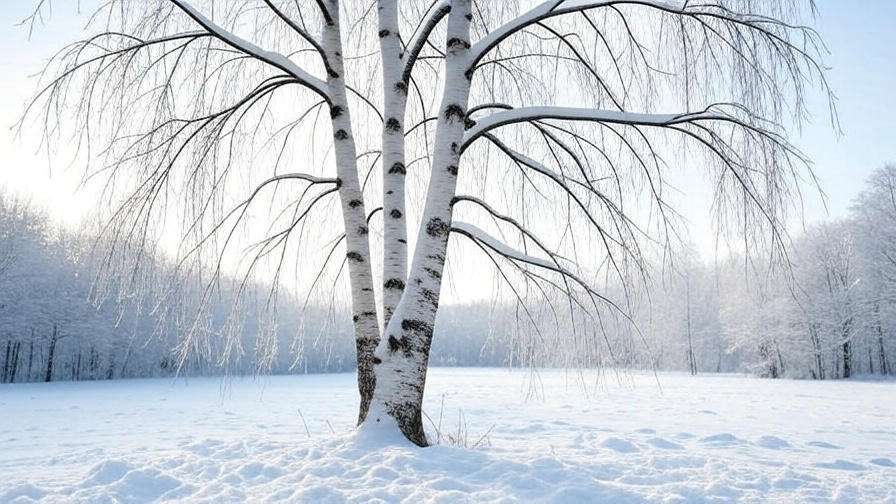
4. Watch Out for Sap Flow 
Birch trees are notorious for their sap flow, especially in early spring. If you trim them too early in the season, the sap can start flowing excessively, leading to a “bleeding” effect. While this doesn’t harm the tree, it’s best to avoid it for aesthetic reasons. Pruning during dormancy prevents this issue.
5. Shape and Size Matter 
Birch trees, with their delicate branches, benefit from light pruning rather than heavy cuts. You can thin out crowded areas and remove any diseased or broken branches. Keep the natural shape intact, and don’t remove too much from the canopy, as birch trees rely on their leaves for energy and overall health.
By understanding these key growth patterns of birch trees, you’ll be better equipped to trim them at the right time, keeping them healthy and beautiful for years to come.
The Best Time to Trim Birch Trees 
When it comes to trimming birch trees, timing is key to ensuring healthy growth and stronger branches. Birch trees, with their beautiful white bark and delicate leaves, need proper care to thrive. Trimming them at the right time will help avoid stress, promote new growth, and keep them looking their best.
Ideal Time: Late Winter to Early Spring 

The best time to trim birch trees is during the late winter or early spring, just before the new growth begins. This timing allows the tree to heal quickly and minimizes the risk of disease. Here’s why:
- Dormant Period: During winter, birch trees are dormant, meaning they aren’t actively growing. Pruning them during this time reduces the chances of sap bleeding, which can happen if you cut too early in the season.
- Healthy New Growth: Trimming before the spring growth spurt encourages new, healthy shoots that will develop throughout the warmer months
- Avoid Summer Sap Flow: Birches are known for their sap flow, and trimming during the warmer months (like late spring or summer) can lead to excessive sap loss, weakening the tree.
What to Avoid 
- Fall Pruning: Avoid trimming in the fall as the tree is preparing for winter dormancy. Cutting during this time can leave the tree more vulnerable to cold damage and disease.
- Hot Summer Months: Don’t trim during peak summer heat. Not only does this stress the tree, but it can also increase the risk of pests and diseases.
How to Trim Birch Trees Effectively 
- Focus on Dead or Damaged Branches: Always start by removing dead or diseased branches. This helps improve the tree’s overall health and appearance.
- Avoid Cutting Too Much: Trim only 10-20% of the tree’s branches at a time. Over-pruning can harm the tree, leading to weak growth and a poor structure.
- Use Sharp, Clean Tools: Make sure your pruning tools are clean and sharp to prevent damaging the tree or spreading diseases.
Why Timing Matters 
Pruning at the right time not only encourages healthy growth but also minimizes stress on the tree. Proper timing promotes vigorous spring growth, keeps birch trees strong and disease-resistant, and ensures they continue to be a beautiful addition to your landscape.
By trimming birch trees at the right time, you’ll help them flourish and maintain their stunning beauty for years to come!
Risks of Trimming Birch Trees at the Wrong Time 

Trimming birch trees at the wrong time can lead to a variety of issues that can harm the tree’s health and growth. To ensure your birch tree thrives, it’s essential to know when to trim it and, just as importantly, when not to trim it. Here are some of the risks of trimming birch trees at the wrong time:
1. Increased Susceptibility to Disease 
Birch trees are especially prone to fungal infections, such as birch borer, when pruned during the wrong season. If you trim the tree during late spring or early summer, it exposes fresh cuts that are more vulnerable to pests and pathogens. Trimming during dormant periods, typically in late fall or winter, helps reduce this risk.
2. Unwanted Sap Dripping 
Trimming birch trees in early spring, just as they begin to “wake up,” can cause sap to leak from the freshly cut branches. This sap dripping is not only messy but also weakens the tree by depleting its resources. The best time to prune is after the sap has stopped flowing (typically in late winter) to avoid this issue.
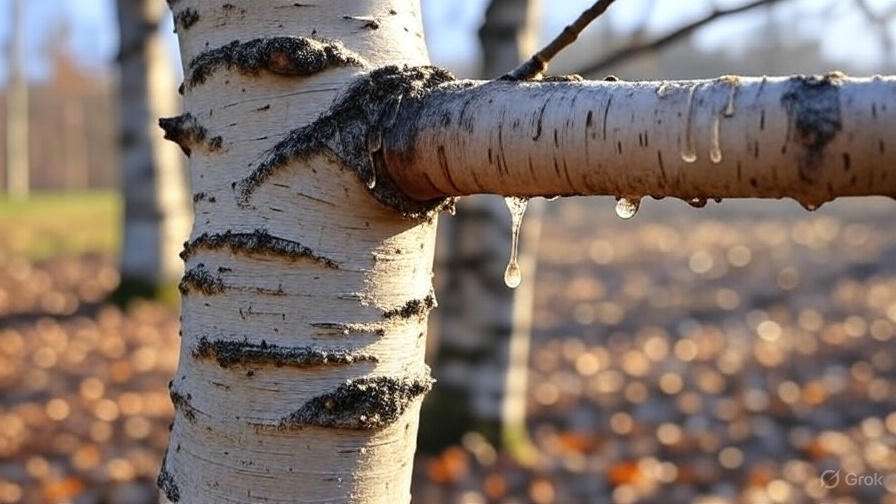
3. Stress on the Tree 
Pruning at the wrong time can cause unnecessary stress. During active growth periods, the tree is using a lot of energy for new leaves and branches. Trimming the tree during this time interrupts this natural process, which can weaken the tree and slow its growth. Prune while the tree is dormant to minimize this impact and allow for healthier regrowth.
4. Weak Growth and Poor Branch Development 
Incorrect pruning timing can also result in poor branch development. If you trim too early in the season, the tree might not have enough time to heal and form strong, healthy new growth. Pruning at the right time encourages better branch strength and improves the overall structure of the tree.
5. Longer Recovery Time 
Birch trees need time to heal after pruning, and trimming during active growth can delay recovery. If done too late in the season, it might not leave enough time for the tree to properly close wounds before colder weather sets in. This can make the tree more vulnerable to frost damage and winter stress.
Conclusion 
To keep your birch tree healthy, avoid pruning during its active growing season—especially during the spring. The best window for trimming is late fall or winter when the tree is dormant. By pruning at the right time, you protect your birch from pests, diseases, and unnecessary stress, allowing it to grow strong and vibrant year after year!
This approach not only ensures that your tree stays healthy but also helps maintain its beauty and strength for the long haul!
How to Trim Birch Trees Safely and Effectively 
Trimming birch trees is a great way to keep them healthy and looking their best. But, like any tree care, it’s important to do it correctly to avoid damage and promote growth. Here’s a simple guide on how to trim birch trees safely and effectively:
1. Choose the Right Time to Trim 
The best time to trim birch trees is late winter or early spring, before they start to bud. This is when they’re still dormant, and you can avoid causing stress to the tree or affecting its growth cycle. If you trim during this period, you can also prevent the tree from “bleeding” sap, which is a common issue if done at the wrong time.
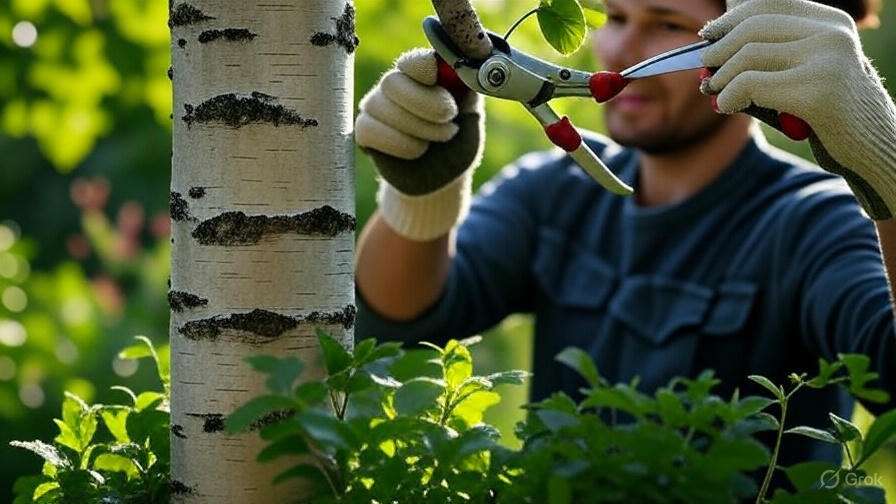
2. Gather Your Tools 
Make sure you have the right tools before starting:
- Pruning Shears: For small branches (up to ¾ inch thick)
- Loppers: For medium-sized branches (¾ to 1 inch thick)
- Pruning Saw: For larger branches (1 inch or more)
- Gloves: To protect your hands
Sharp tools will make clean cuts that heal faster and reduce the risk of infections. If your tools are dull, sharpen them before you start!
3. Start by Removing Dead or Damaged Branches 
Look for any dead, damaged, or diseased branches. These are not only unattractive but can also be a breeding ground for pests or disease. Cut these branches back to the base or a healthy branch junction. Always make sure to cut at a 45-degree angle to encourage healthy regrowth.
4. Thin Out the Canopy for Better Airflow 
Birch trees tend to grow dense canopies, which can restrict airflow and sunlight. By thinning out some of the inner branches, you’ll allow better air circulation and light penetration. This promotes overall tree health, reduces the risk of diseases, and encourages more vibrant leaves.
- Cut out crossing branches: If two branches are rubbing against each other, remove one to avoid damage.
- Focus on the interior: Remove branches that are growing inward, leaving space for the remaining healthy branches to grow.
5. Trim for Shape and Structure 
You don’t want to drastically alter the shape of your birch tree, but a little shaping can help it look neat and maintain its natural form. Remove any overly long or unruly branches that disrupt the tree’s balance. Avoid cutting too much from the top, as this could affect the tree’s stability and overall structure.
6. Cut at the Right Angle 
When you’re making cuts, always cut at a slight angle (about 45 degrees) just above a bud or branch junction. This helps water run off and promotes faster healing. The goal is to create a clean cut that minimizes the chance of disease entering the tree.
7. Don’t Overdo It! 
It’s easy to get carried away when trimming, but avoid cutting more than 25% of the tree’s canopy at once. Removing too much foliage can stress the tree and harm its health. Always take a step back and assess the tree before making further cuts.
8. Dispose of the Trimmings Properly 
After you’re done trimming, make sure to clean up all the cut branches. If any branches were diseased, dispose of them properly to prevent the spread of illness. Composting or leaving the trimmings on the ground can encourage pest problems, so it’s better to remove them from the area entirely.
9. Monitor the Tree After Trimming 
Once you’ve finished, keep an eye on your birch tree for the next few weeks. If you notice any signs of stress, like browning leaves or unusual growth patterns, you might have cut too much or at the wrong time. Don’t hesitate to consult a professional if you’re unsure about your trimming technique.
By following these easy steps, you can trim your birch tree safely, ensuring it stays healthy and beautiful. Proper trimming not only improves the appearance of your tree but also supports its long-term growth and vitality. Happy trimming!
Post-Trimming Care and Maintenance for Birch Trees 
After trimming your birch tree, it’s important to give it the right care to ensure it thrives and continues to grow strong and healthy. Proper post-trim maintenance can help the tree recover quickly, minimize stress, and prevent infections. Here are some simple and effective steps you can take:
1. Watering 
Birch trees need consistent moisture to heal and grow. After trimming, ensure your tree gets enough water, especially during dry periods. Water deeply at the base to encourage strong root development. Avoid overwatering, as this can lead to root rot. Aim for moist, well-drained soil.
2. Mulching 
Apply a 2-3 inch layer of organic mulch around the base of the tree, but keep it a few inches away from the trunk. Mulch helps retain moisture, regulate soil temperature, and suppress weeds. It also prevents damage from lawn mowers or trimmers.
3. Monitor for Pests and Diseases 
Birch trees are vulnerable to certain pests and diseases, especially after pruning. Keep an eye out for signs of trouble, such as yellowing leaves, leaf spots, or insect activity. If you notice anything unusual, take action immediately to prevent further damage. A quick response can save your tree from more serious issues.
4. Avoid Fertilizing Right After Trimming 
While fertilizing can boost growth, it’s best to avoid feeding your birch tree immediately after trimming. The tree needs time to recover from the stress of pruning. Wait until the next growing season to fertilize, unless your tree shows signs of nutrient deficiency.
5. Proper Sunlight 
Birch trees love sunlight, so ensure they get at least 4-6 hours of direct sunlight per day. After trimming, make sure the canopy is still open enough to allow light to reach the lower branches. If necessary, remove any excess foliage that may block sunlight from getting through.
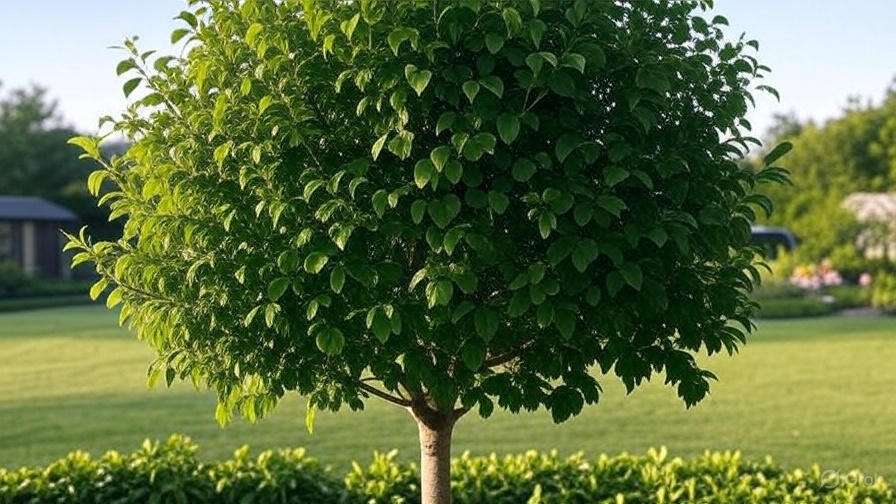
6. Prune Only When Necessary 
If you need to trim again within the same season, do so with caution. Over-pruning can stress your birch tree. Only trim dead or diseased branches, or any that are rubbing against each other. This ensures the tree has enough foliage to support its growth.
7. Patience is Key 
Birch trees need time to recover after trimming. Don’t be discouraged if the tree doesn’t show immediate signs of new growth. With proper care, it will bounce back and continue to grow strong.
By following these simple steps, you can help your birch tree heal from trimming and maintain its health for years to come. Regular care and attention will reward you with a beautiful, flourishing tree 
Common Mistakes to Avoid When Trimming Birch Trees 

Trimming birch trees can keep them healthy and beautiful, but it’s easy to make a few mistakes that could harm their growth. Here are some common errors to watch out for and how to avoid them:
1. Trimming at the Wrong Time 
The timing of your trim is critical. Birches should generally be pruned in late winter or early spring, just before new growth begins. Avoid trimming in late spring or summer when the tree is actively growing, as this can cause bleeding (excess sap leakage) and weaken the tree. Always check the season before making any cuts!
2. Cutting Too Much at Once 

Pruning too much of the tree at once can stress it out and leave it vulnerable to disease or pests. Focus on removing only dead, damaged, or diseased branches. A good rule of thumb is to never remove more than 25-30% of the tree’s canopy in a single season.
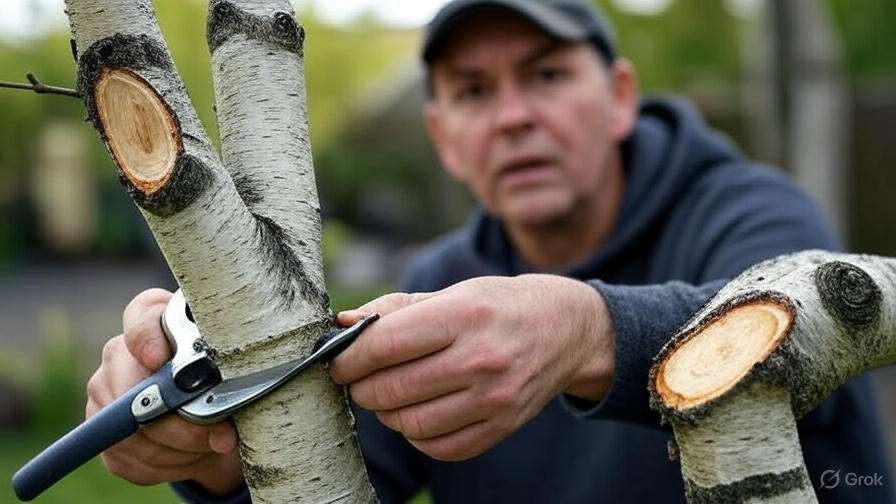
3. Using Dull or Dirty Tools 
Sharp and clean tools are essential for a clean cut. Dull shears can cause jagged wounds, inviting disease, while dirty tools may spread infections between trees. Always clean your tools with rubbing alcohol before you start trimming. A sharp, clean cut will heal faster and help your tree stay healthy.
4. Not Making Proper Cuts 
When cutting branches, ensure your cuts are clean and precise. Avoid leaving stubs (the leftover part of the branch) or cutting too close to the trunk. Both mistakes can lead to poor healing or damage to the bark, opening the door for infections. Make cuts just outside the branch collar (the bulging area where the branch meets the trunk) to allow the tree to seal the wound properly.
5. Neglecting to Shape the Tree 
While it’s important to remove dead or diseased branches, you should also pay attention to the overall shape of the tree. Trimming birch trees for structure helps them grow in a balanced, strong form. This can prevent problems with weak branches and improve airflow, reducing the risk of pests.
6. Ignoring Safety Precautions 
Trimming birch trees can be physically demanding and involve climbing ladders or using sharp tools. Always wear gloves, protective glasses, and a hard hat if needed. If you’re dealing with larger branches or working at a height, consider hiring a professional arborist to avoid accidents.
By avoiding these common mistakes, you’ll help ensure your birch tree stays healthy, beautiful, and vibrant for years to come. Follow these simple tips, and your trimming efforts will truly pay off!
Conclusion 
In summary, knowing when to trim birch trees is key to promoting their health and longevity. By trimming during late winter or early spring—before new growth begins—you’ll minimize sap loss, reduce stress on the tree, and encourage stronger, healthier branches. Avoid trimming in late fall, summer, or once the tree has started pushing out new buds to prevent unnecessary damage and disruption to its growth cycle.
Remember, always use clean, sharp tools and avoid over-trimming. With the right techniques and timing, your birch tree will thrive season after season, enhancing both the beauty and health of your landscape.
So, whether you’re a seasoned gardener or a beginner, applying these simple yet effective tips will ensure your birch trees stay strong, vibrant, and full of life.
Now that you have the knowledge, it’s time to get out there and give your birch tree the care it deserves. Happy trimming!
Frequently Asked Questions(FAQ)
When is the best time to trim birch trees?
The best time to trim birch trees is in late winter or early spring, before new growth begins. This timing ensures the tree is dormant, minimizing sap loss and stress while allowing the tree to heal quickly after the cut.
Can I trim my birch tree in the summer?
It’s not recommended to trim birch trees in the summer. Summer pruning can interfere with the tree’s energy reserves and cause stress, potentially stunting its growth and making it more vulnerable to disease.
Why does birch sap flow when trimming?
Birch trees release sap during late winter or early spring, which is when they’re preparing to grow. Trimming during this time may lead to excessive sap loss, but it’s generally not harmful if done properly and minimally.
Can I trim my birch tree in the fall?
Trimming birch trees in the fall is discouraged because it can expose the tree to harsh weather and potential disease. It’s best to wait until late winter or early spring when the tree is dormant.
How do I know if my birch tree needs trimming?
Look for dead, damaged, or diseased branches that are affecting the tree’s structure. Also, check for branches that are crossing or overcrowding, as trimming these can improve airflow and light penetration.
What tools do I need to trim a birch tree?
You’ll need sharp pruning shears or loppers for smaller branches, and a pruning saw for larger limbs. Always wear protective gloves and safety glasses to avoid injury.
Can I trim birch trees during their growing season?
It’s not ideal to trim birch trees during their active growing season (spring through summer). Trimming during this time can stress the tree and affect its growth. Stick to trimming when the tree is dormant for the best results.
Should I apply anything to the cuts after trimming my birch tree?
It’s generally not necessary to apply sealant or tar to the cuts on birch trees. Allow the tree to naturally seal the wound. Just make sure to trim cleanly to prevent disease entry and ensure the tree heals properly.


